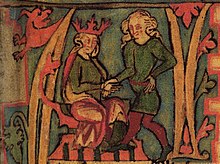Harald I of Norway
| Harald Fairhair | |||||
|---|---|---|---|---|---|

Harald Fairhair, in an illustration from the 14th century Flateyjarbók.
|
|||||
| King of Norway | |||||
| Reign | 872–930 | ||||
| Successor | Eric I | ||||
| Born | c. 850 | ||||
| Died |
c. 932 Rogaland, Norway |
||||
| Burial | Haraldshaugen in Haugesund | ||||
| Spouse | Ragnhild Eriksdotter Åsa Håkonsdotter |
||||
| Issue more |
Eric I of Norway Haakon I of Norway |
||||
|
|||||
| Dynasty | Fairhair dynasty | ||||
| Father | Halfdan the Black | ||||
| Mother | Ragnhild (Haraldsdotter or Sigurdsdotter?) | ||||
| Religion | Norse religion | ||||
| Full name | |
|---|---|
| Haraldr Hálfdanarson |
Harald Fairhair (Old Norse: Haraldr Hárfagri, Norwegian: Harald Hårfagre, (literally "Harald Hair-fair") ; c. 850 – c. 932) is remembered by medieval historians as the first King of Norway. According to traditions current in Norway and Iceland in the twelfth and thirteenth centuries, he reigned from c. 872 to 930. Most of his life remains uncertain, since the extant accounts of his life in the sagas were set down in writing around three centuries after his lifetime. A few remnants of skaldic praise poems attributed to contemporary court poets exist which seem to refer to Harald's victories against opponents in Norway. The information supplied in these poems is inconsistent with the tales in the sagas in which they are transmitted, and the sagas themselves often disagree on the details of his background and biography. Two of his sons, Eric Bloodaxe and Haakon the Good, succeeded Harald to become kings after his death.
The only early sources mentioning him are the two skaldic poems Haraldskvæði and Glymdrápa, which have been attributed to Þorbjörn Hornklofi or alternatively (in the case of the first poem) to Þjóðólfr of Hvinir. The first poem has only been preserved in fragments in 13th century Kings' sagas. It describes life at Harald's court, mentions that he took a Danish wife, and that he won a battle at Hafrsfjord. The second relates a series of battles Harald won.
His life is described in several of the Kings' sagas, none of them older than 12th century. Their accounts of Harald and his life differ on many points, and some of the content may be uncertain but it is clear that in the 12th and 13th centuries Harald was regarded as having unified Norway into one kingdom. Some modern historians have assumed that his rule was limited to the coastal areas of southern Norway though there is no contemporary evidence to support their claim nor any other concerning the life of Harald.
...
Wikipedia
